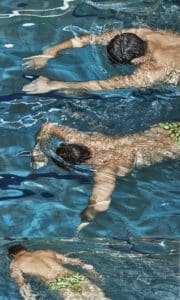Feel The Water – Sculling

Watch the great swimmers’ hands, and you’ll see how soft they are when they swim. They’re always searching to find that constant connection with the water. The way to improve this is using a technique or drill called sculling. Sculling provides the building blocks to all four swim strokes and teaches us to feel pressure against the water on our hands and forearms. If you have this connection or pressure on the water, you will go forward – the more pressure you exert, the quicker you will go. However, if you don’t “feel” the water, you won’t go anywhere! Sculling helps us build in this “feel”.
Sculling doesn’t have to be perfect, but it teaches us to generate force in the right direction.
Why Do It:
Sculling in all directions helps you develop a better feel for the water. Strapless sculling, or using paddles that have limited connection to the hands, helps you feel the press of the scull, while still focusing on having the palms turned in the correct direction.
How to Do It:
1. Start with your feet behind you, on your back.
2. Start to scull with your fingertips facing UP. If you do this right, you should move backwards.
3. Now simply turn the fingertips DOWN. If you do this right, you should move forward, toward the feet.
4. Remember: This isn’t pulling. Don’t sweep your hands around like this swimmer is doing.
5. Sweep back and forth with the hands while keeping the shoulders and elbows as still as possible.
How to Do It Really Well (the Fine Points):
Remain completely still with everything except the lower arm. Keep the body steady, the arms, the head… remain like a rock except for the lower arms and hands. If you have to kick to keep the feet up, sometimes a pull buoy can help further isolate what you’re focusing on.
Once you’ve mastered the basics, you can go for more stroke specific points – entry point (out in front, full extension, some people refer to this as catch point), midpoint (with your elbows forward and wide, forearms pointing down) and exit point (similar to the drill above but lying on your front, working on finishing your stroke).

Entry point scull, midpoint scull, exit point scull
If you have any questions or comments, please feel free to get in touch; either by email, facebook or leave a comment on here!
See what’s up next week for our #SwimTechTues tip!
Remember, if you feel like you could do with some help getting some control of the water, you can always book in for a 121 swim or video swim analysis below.
